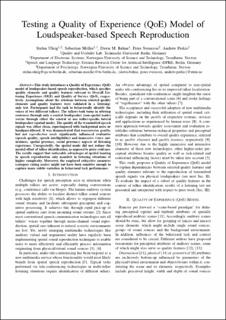| dc.contributor.author | Uhrig, Stefan | |
| dc.contributor.author | Möller, Sebastian | |
| dc.contributor.author | Behne, Dawn Marie | |
| dc.contributor.author | Svensson, U. Peter | |
| dc.contributor.author | Perkis, Andrew | |
| dc.date.accessioned | 2021-03-17T09:56:53Z | |
| dc.date.available | 2021-03-17T09:56:53Z | |
| dc.date.created | 2021-01-25T11:42:23Z | |
| dc.date.issued | 2020 | |
| dc.identifier.citation | 2020 Twelfth International Conference on Quality of Multimedia Experience (QoMEX) | en_US |
| dc.identifier.isbn | 978-1-7281-5965-2 | |
| dc.identifier.uri | https://hdl.handle.net/11250/2733841 | |
| dc.description.abstract | This study introduces a Quality of Experience (QoE) model of loudspeaker-based spatial speech reproduction, which specifies quality elements and quality features relevant to overall listening experience and Quality of Service (QoS), respectively. Assumptions about the relations between selected quality elements and quality features were validated in a listening-only test. Participants had the task to behaviorally identify the voices of two talkers and provided subjective judgments on category rating scales. Sentences uttered by the two talkers were alternately presented through only a central loudspeaker (non-spatial mode) versus through either the central or one talker-specific lateral loudspeaker (spatial mode). The transmitted speech signals were clean, superimposed with background noise or bandpass-filtered. Results showed that transmission quality, but not reproduction mode significantly affected evaluative (speech quality, speech intelligibility), immersion (voice naturalness, spatial presence, social presence) and task-related (voice similarity, talker identification effort) aspects of overall listening experience. Contrary to previous findings, the spatial mode did not reduce the effort of talker identification. This suggested that noticeable advantages from spatial reproduction may not be evident in relatively simple listening situations, but could manifest if complexity is increased. Besides their task-related influence, noise and spectral distortion should be mitigated when targeting a higher level of immersion. | en_US |
| dc.language.iso | eng | en_US |
| dc.publisher | IEEE | en_US |
| dc.relation.ispartof | 2020 Twelfth International Conference on Quality of Multimedia Experience (QoMEX) | |
| dc.title | Testing a Quality of Experience (QoE) Model of Loudspeaker-based Spatial Speech Reproduction | en_US |
| dc.type | Chapter | en_US |
| dc.description.version | acceptedVersion | en_US |
| dc.description.version | acceptedVersion | |
| dc.identifier.doi | 10.1109/QoMEX48832.2020.9123119 | |
| dc.identifier.cristin | 1878292 | |
| dc.description.localcode | © 2020 IEEE. Personal use of this material is permitted. Permission from IEEE must be obtained for all other uses, in any current or future media, including reprinting/republishing this material for advertising or promotional purposes, creating new collective works, for resale or redistribution to servers or lists, or reuse of any copyrighted component of this work in other works | en_US |
| cristin.ispublished | true | |
| cristin.fulltext | preprint | |
| cristin.fulltext | postprint | |
| cristin.qualitycode | 1 | |
